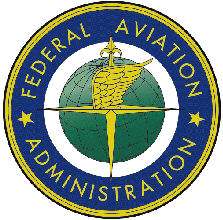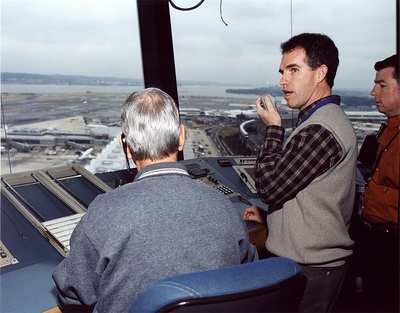Visit Comes Amid Three-State Glitch
 FAA Administrator Marion C. Blakey
and Congressman John L. Mica (R-FL, Dist. 7) today visited Harris
Corporation's headquarters in Melbourne (FL) Tuesday, to meet with
company executives and tour the FAA's Primary Network Operations
and Control Center (PNOCC), which is also located in Melbourne and
operated jointly by Harris and the FAA. The PNOCC is the main
operations center from which the FAA's nationwide communications
network is monitored and managed. The PNOCC is part of the $1.9
billion FAA Telecommunications Infrastructure (FTI) program awarded
to Harris in July 2002.
FAA Administrator Marion C. Blakey
and Congressman John L. Mica (R-FL, Dist. 7) today visited Harris
Corporation's headquarters in Melbourne (FL) Tuesday, to meet with
company executives and tour the FAA's Primary Network Operations
and Control Center (PNOCC), which is also located in Melbourne and
operated jointly by Harris and the FAA. The PNOCC is the main
operations center from which the FAA's nationwide communications
network is monitored and managed. The PNOCC is part of the $1.9
billion FAA Telecommunications Infrastructure (FTI) program awarded
to Harris in July 2002.
The visit came as a mysterious computer glitch forced
controllers to ground all flights in New Mexico, Texas and
Louisiana for up to two hours.
"At this point in time, we're just trying to catch up. There
were some flights that were experiencing as much as two-hour
delays. But at this point, I think we'll be able to catch up by
noon, or by sometime this afternoon," said Houston Airports
spokesman Ernie DeSoto. "The problem that happens is that all of
these flights are interrelated -- they connect to other cities and
other flights."
There was no indication of what caused the delay -- the FAA
would only say "major computer problems" were to blame.
Back In Melbourne...
 "We are delighted that Ms. Blakey
and Congressman Mica have taken the opportunity to tour this
world-class network operations center, built with Harris technology
and now operated by a co-located FAA/Harris team," said Howard L.
Lance, Harris chairman and CEO. "This facility is integral to the
FAA's objective for a modern, efficient, and highly reliable
telecommunications system that further strengthens the US civil
aviation system as the safest and most efficient in the world. The
FAA is our largest US civil agency customer and FTI represents our
single largest program at Harris."
"We are delighted that Ms. Blakey
and Congressman Mica have taken the opportunity to tour this
world-class network operations center, built with Harris technology
and now operated by a co-located FAA/Harris team," said Howard L.
Lance, Harris chairman and CEO. "This facility is integral to the
FAA's objective for a modern, efficient, and highly reliable
telecommunications system that further strengthens the US civil
aviation system as the safest and most efficient in the world. The
FAA is our largest US civil agency customer and FTI represents our
single largest program at Harris."
"FTI is designed to save the FAA more than $600 million in
telecommunications operating costs over the life of the program,
and therefore represents a significant savings for a critical
government agency," said Congressman Mica. "As a legislator from
the great state of Florida and a member of the House Committee on
Transportation and Infrastructure, I am proud that a Florida-based
company such as Harris is leading the effort to not only maximize
transportation-related efficiencies but to also improve network
security, both of which are the committee's top priorities."
The PNOCC exclusively serves the FAA as a centralized and
integrated network operations center for all operational
communications needs throughout the agency's 5,000 facilities
nationwide. This dedicated, around-the-clock control center allows
co-located Harris and FAA personnel to respond to and handle
virtually all communications requirements so that the agency can
focus on its top priority -- managing the nation's air traffic.
"The PNOCC is essential to managing and monitoring FAA
operations nationwide," said Bob Henry, corporate senior VP, and
president, Harris Government Communications Systems Division
(GCSD). "FAA and Harris personnel are working hand-in-hand in this
central facility in Melbourne to ensure that maximum efficiencies,
availability, and security are realized throughout the entire FTI
network, which provides the communications backbone for the FAA's
critical civil aviation mission, a key component of both US
national security and economic vitality."

The PNOCC is a state-of-the-art control center supported by a
redundant, robust architecture housed within a 6,500-square foot
facility. Physical building security, redundant climate control
systems, and uninterruptible power ensure system and facility
availability with zero downtime. Security features such as
firewalls, intrusion detection sensors, and encryption devices
safeguard system integrity. The center provides centralized, timely
network security and performance management information, as well as
serving as the focal point for problem reporting and network status
for all FAA users. A remote backup NOCC provides further
redundancy.
Last October, the Air Traffic Control Association (ATCA) awarded
Harris its prestigious 2003 Industrial Award. The award is given
annually to a government contractor for significantly enhancing the
safety, quality, and efficiency of the nation's air traffic control
system. The award recognized Harris' long history of developing and
integrating system solutions for the FAA and the global air traffic
control network. The company's work on FTI was a major factor in
receiving the award. Other FAA programs developed by Harris are the
Weather And Radar Processor (WARP); the Operational And
Supportability Implementation System (OASIS); the Voice Switching
and Control System (VSCS); and the Alaskan NAS Interfacility
Communications System (ANICS).
 Aero-FAQ: Dave Juwel's Aviation Marketing Stories -- ITBOA BNITBOB
Aero-FAQ: Dave Juwel's Aviation Marketing Stories -- ITBOA BNITBOB NTSB Prelim: Rutan Long-EZ
NTSB Prelim: Rutan Long-EZ ANN's Daily Aero-Term (12.05.25): Hazardous Weather Information
ANN's Daily Aero-Term (12.05.25): Hazardous Weather Information Aero-News: Quote of the Day (12.05.25)
Aero-News: Quote of the Day (12.05.25) Airborne-Flight Training 12.04.25: Ldg Fee Danger, Av Mental Health, PC-7 MKX
Airborne-Flight Training 12.04.25: Ldg Fee Danger, Av Mental Health, PC-7 MKX




